TMC Releases Two Economic Studies with Combined NPV of $23.6B and Declares World-First Nodule Reserv
- TMC published two technical economic assessments prepared in accordance with Subpart 1300 of Regulation S-K highlighting a total combined project value of $23.6 billion, showing potential economic viability of its NORI-D Project and significant scalability across other NORI and TOML areas
- World-first Pre-Feasibility Study (PFS) for a polymetallic nodule project in the NORI-D area with a Net Present Value (NPV) of $5.5 billion
- The PFS Technical Report Summary (TRS) marks a world-first declaration of Mineral Reserves for a polymetallic nodule project with 51 million tonnes (Mt) of probable mineral reserves;
- Measured, indicated and inferred mineral resources exclusive of reserves of 274 Mt of wet nodules are expected to provide an additional 113 Mt of recoverable nodules once detailed survey and mine planning is complete;
- In light of recent U.S. regulatory developments, TMC expects to commence commercial production in the fourth quarter of 2027 if we receive a commercial permit before scaling to an average targeted annual production rate of 10.8 million tonnes of wet nodules per annum (Mtpa) at steady state (2031 through 2043) production, with an expected 18-year life of mine (LOM);
- Expected annual steady state production rate of 97 kilotonnes per annum (ktpa) nickel, 2,389 ktpa manganese, 70 ktpa copper and 7.4 ktpa cobalt
- Expected low first quartile cost of production with cash costs of $1,065 per tonne of nickel including byproduct credits and All-In Sustaining Costs (AISC) of $2,569 per tonne of nickel including byproduct credits
- Projected after-tax NPV of $5.5 billion and After-tax Internal Rate of Return (IRR) of 27%
- Steady state average EBITDA margin of 43%
- New Initial Assessment details the economic potential of the rest of the 1.3 billion tonne resource across the NORI and TOML areas (excluding NORI-D) and a total estimated resource Net Project Value of $18.1 Billion
- Projected After-tax NPV of $18.1 Billion and IRR of 36%
- Projected steady state (2039 through 2058) average EBITDA margin of 57%
NEW YORK, Aug. 04, 2025 (GLOBE NEWSWIRE) -- TMC the metals company Inc. (Nasdaq: TMC), a leading developer of the world's largest estimated undeveloped resource of critical metals essential to energy, defense, manufacturing and infrastructure, today announced the release of a Technical Report Summary (TRS) of the Pre-Feasibility Study (PFS) for its proposed NORI-D Polymetallic Nodule Project in the Clarion Clipperton Zone (CCZ) of the Pacific Ocean, prepared in accordance with Subpart 1300 of SEC Regulation S-K (SK-1300). The PFS marks a world-first declaration of Probable Mineral Reserves for deep-sea polymetallic nodules and was prepared and signed off by Qualified Persons, including AMC Consultants.
Alongside the PFS, TMC announced the publication of an Initial Assessment (IA) for the remainder of its resource in the NORI and TOML blocks in the CCZ, with a measured and indicated mineral resource of 73Mt of wet nodules grading 1.30% nickel, 0.20% cobalt, 1.2% copper and 30.2% manganese with an abundance of 12.8 Kg/m2 and an inferred mineral resource of 1206 Mt of wet nodules grading 1.30% nickel, 0.20% cobalt, 1.1% copper and 28.7% manganese with an abundance of 11.6 Kg/m2 supporting an After-tax NPV of $18.1 billion and After-tax IRR of 35.6%.
The two mineral resource reports follow TMC USA's April 2025 submission of an application for a commercial recovery permit under the U.S. Deep Seabed Hard Mineral Resources Act (DSHMRA), along with two exploration license applications. The reports also come on the heels of a strategic investment from Korea Zinc—one of the world's largest and most respected non-ferrous metal smelting groups. Together, these milestones reinforce TMC's first-mover advantage in unlocking the world's largest estimated undeveloped deposit of critical minerals and reflect growing confidence in the NORI-D Project's economics and development plan as the U.S. and allied nations work to strengthen critical mineral supply chains.
Follow these links to read the reports: Technical Report Summary for the PFS; Technical Report Summary for the Initial Assessment of the remaining NORI and TOML resource.
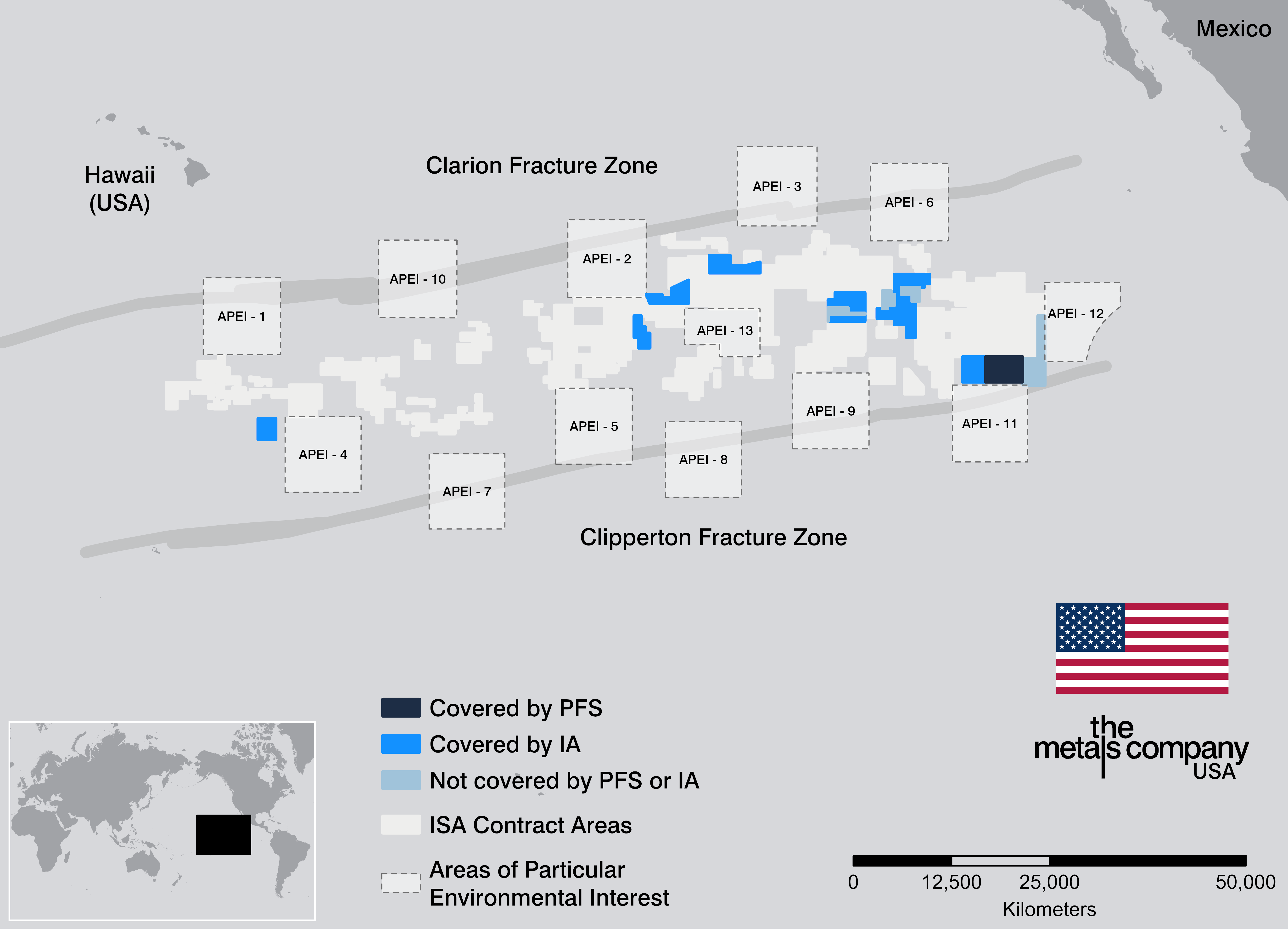
Gerard Barron, Chairman and CEO of TMC, commented: “The combined net present value of $23.6 billion of the two studies should give investors a better idea of the economic potential of our total estimated resource. The PFS takes our NORI-D Project economics up the confidence curve and contains the declaration of mineral reserves — these are our first 50+ million tonnes with a potential commercially viable path to production, with more to follow as we advance our mine planning work. The phased project development plan will target initial production from the Hidden Gem vessel, with an estimated $113 million of development capital expenditure each from TMC and Allseas. First production is targeted for Q4 2027. This PFS brings us one step closer to responsible production, potentially opening the door to new pools of capital from strategic and government sources, and reinforces TMC's leadership in this emerging industry.”
*The tables below summarize key findings under the PFS and IA. The summary does not purport to be complete and is qualified in its entirety by the PFS and IA. Readers are encouraged to read the PFS and IA in their entirety.
PFS and IA at a Glance.
| Unit | PFS | IA | |
| Mine Life | Years | 18 | 23 |
| Total Nodule Production | Million tonnes (wet) | 164 | 670 |
| Nameplate Production Capacity | Million tonnes per annum (wet) | 12 | 40 |
| Average Nickel Grade | % | 1.40 | 1.31 |
| Average Cobalt Grade | % | 0.14 | 0.19 |
| Average Copper Grade | % | 1.14 | 1.13 |
| Average Manganese Grade | % | 31.15 | 29.35 |
| Average Nickel Recovery | |||
| Nodules to Alloy | % | 96.9 | N/A |
| Nodules to Matte | % | 94.8 | 94.8 |
| Nodules to Sulfate | % | 94.6 | 94.6 |
| Average Cobalt Recovery | |||
| Nodules to Alloy | % | 93.1 | N/A |
| Nodules to Matte | % | 77.5 | 77.5 |
| Nodules to Sulfate | % | 77.2 | 77.2 |
| Average Copper Recovery | |||
| Nodules to Alloy | % | 93.6 | N/A |
| Nodules to Matte | % | 86.4 | 86.4 |
| Nodules to Cathode | % | 86.2 | 86.2 |
| Average Manganese Recovery (as Mn Silicate) | % | 98.9 | 98.9 |
| Total LOM Operating Costs | US$ million | 39,978 | 126,175 |
| LOM Offshore Collection | US$ million | 12,344 | 31,139 |
| LOM Transfer & Shipping | US$ million | 3,071 | 6,066 |
| LOM Contractor Costs | US$ million | 1,855 | 3,584 |
| LOM Consumables (offshore fuel) | US$ million | 3,848 | 11,884 |
| LOM Onshore Processing | US$ million | 13,622 | 53,598 |
| LOM Refining Costs | US$ million | 3,254 | 15,978 |
| LOM Corporate (G&A) | US$ million | 1,985 | 3,926 |
| All-In Sustaining Costs incl. Byproduct Credits (non-GAAP1) | US$ per tonne of Nickel | 2,569 | (5,903) |
| C1 Cash Costs incl. Byproduct Credits (non-GAAP1) | US$ per tonne of Nickel | 1,065 | (6,939) |
| Total Project Capital excl. Escalation |
US$ million | 4,918 (492 Offshore +4,426 US refining) | 8,852 |
| Valuation Metrics | |||
| Price of Nickel Metal | Average US$ per tonne2 | 20,295 | 20,360 |
| Price of Nickel Sulfate | Average US$ per tonne2 | 21,633 | 21,835 |
| Price of Manganese Silicate | Average US$ per dmtu2,3 | 5.45 | 4.71 |
| Price of Copper Cathode | Average US$ per tonne2 | 11,440 | 11,456 |
| Price of Cobalt Metal | Average US$ per tonne2 | 56,117 | 62,530 |
| Price of Cobalt Sulfate | Average US$ per tonne2 | 55,198 | 62,530 |
| Discount Rate | % | 8 | 8 |
| After-Tax Net Present Value (NPV) | US$ billion | 5.508 | 18.081 |
| After-Tax Internal Rate of Return (IRR) | % | 26.8 | 35.6 |
1 Generally Accepted Accounting Principles
2 weighted average based on production schedule and commodity prices
3dmtu: dry metric tonne unit
PFS Technical Report Summary Highlights
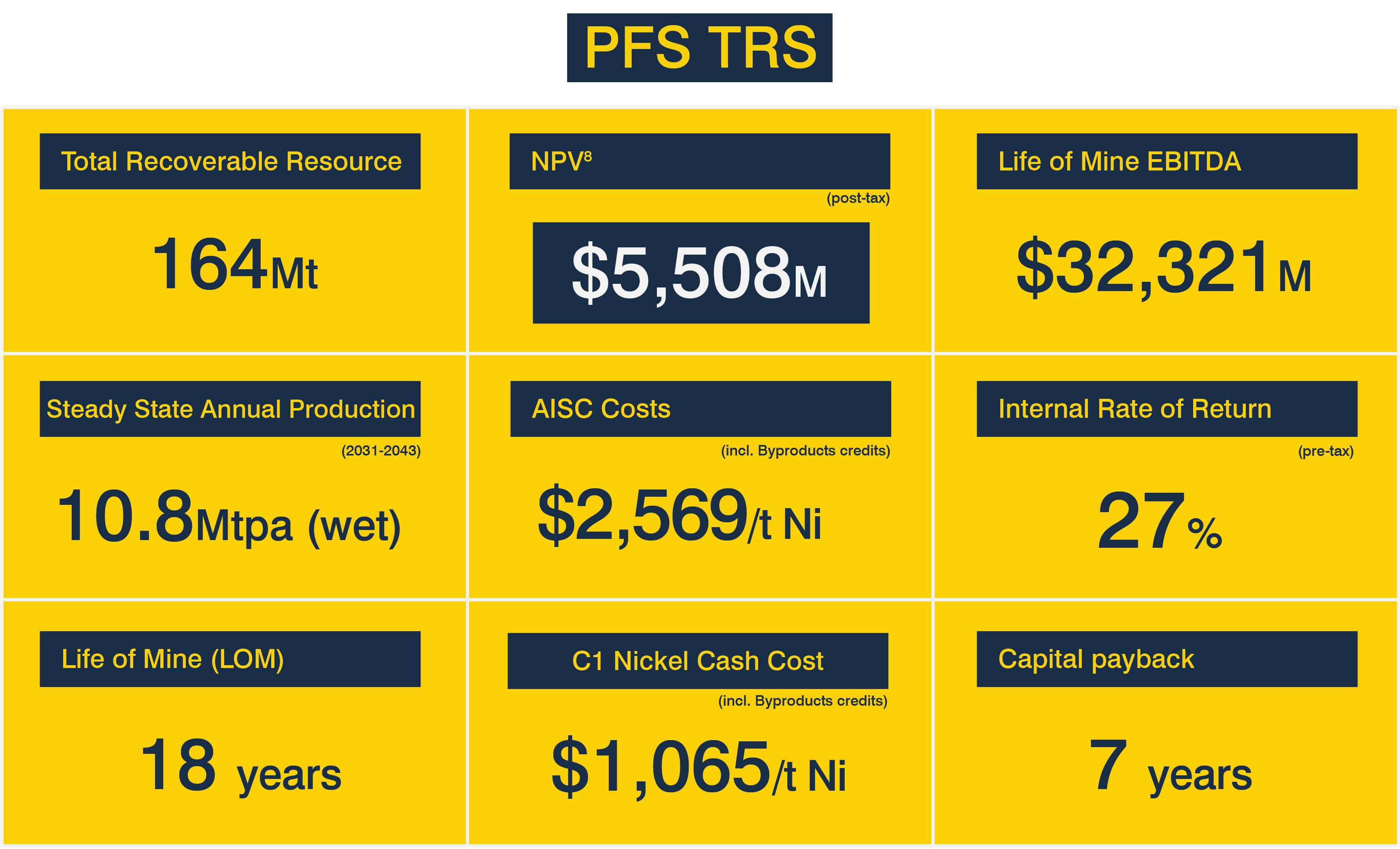
NORI-D Project Pre-Feasibility Study Overview
The Pre-Feasibility Study assumes that developing and operating the NORI-D Project is not only commercially and technically achievable but can begin with a capital-light approach by leveraging existing offshore and onshore infrastructure.
The PFS outlines a phased development plan for offshore collection and onshore processing of polymetallic nodules, targeting production ramp-up to 12 million tonnes per annum (Mtpa) of wet nodules within the first five years. This production rate supports a projected 18-year mine life for the NORI-D Project.
Initial processing is assumed to rely on proven rotary kiln electric furnace (RKEF) infrastructure in Japan and Indonesia to produce nickel-cobalt-copper alloy and matte intermediates, with final refining at future U.S.-based facilities to deliver battery-grade nickel and cobalt products.
With a first-quartile position on the global nickel cost curve, the NORI-D Project is expected to offer strong cost competitiveness. The project's low all-in sustaining costs is enabled by high metallurgical recoveries and the use of existing infrastructure. The efficient, near-zero solid waste process assumed in the PFS underscores the quality of the nodule resource and reinforces TMC's ability to deliver critical metals responsibly and at scale.
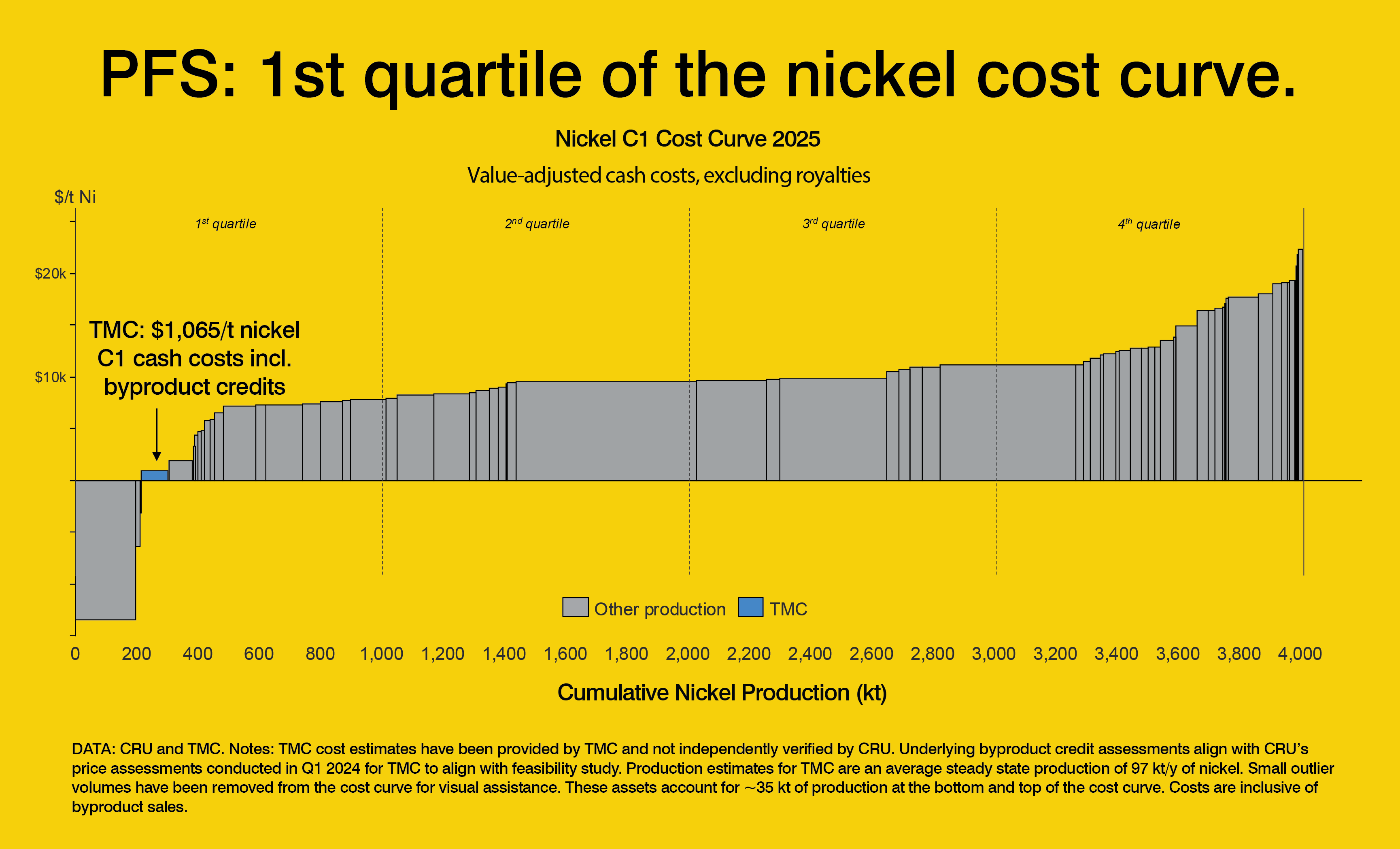
Lean, Focused, Ready: Starting with a Capital-Light Approach
The PFS highlights TMC's capital-light execution strategy which is designed for speed, scalability, and efficiency. By leveraging proven offshore vessels and established onshore processing plants, through tolling agreements, the PFS assumes the minimization of upfront capital costs to get started while streamlining development timelines and reducing operational risk.
At sea, TMC's offshore production system is assumed to feature vessels equipped with dual 15-meter-wide collectors, vertical riser and transport systems, and onboard infrastructure for dewatering, storage, and offloading. Each Production Vessel (PV) is would be be paired with a dynamically positioned Transfer Vessel (TV) to maintain continuous operations — enabling regular offloading of nodules without interrupting collection. Transfer Vessels would then deliver nodules to bulk carriers for shipment to shore, with Support Vessels (SVs) managing refuelling, waste, and crew logistics.
Initial onshore processing is assumed to commence under a 5-year tolling agreement with Pacific Metals Company (PAMCO) utilising existing rotary kiln electric arc furnace facilities at Hachinohe in Japan, allowing for the timely, near-term production of nickel-copper-cobalt alloy and manganese silicate without the need to construct new facilities. It is assumed that PAMCO would process up to 1.3 Mtpa of wet nodules, with TMC expanding capacity through additional tolling partnerships in Indonesia as offshore production volumes ramp up.
Looking ahead, the PFS assumes the construction of two dedicated refining facilities by TMC in the United States. These plants —designed for a combined capacity of 12 Mtpa of wet nodules — would convert intermediate products into high-purity nickel and cobalt sulfates, and copper cathode. TMC plans to own the facilities, with operations handled by experienced strategic partners, with 94% of refining capex spent in the 2030s.
The PFS assumes that Allseas — TMC's major shareholder and strategic partner — is expected to lead the offshore delivery of the project, overseeing engineering, procurement, fabrication, commissioning, and operations of the nodule collection system. Logistics support and shipping services are expected to be delivered by third-party contractors, using bulk carriers and support vessels under long-term charter and service agreements.
As part of its capital-light development strategy, TMC is assumed to contribute to the funding of the initial PV and TV with future vessels to be financed by contractors and repaid through long-term operating agreements over a 10-year period. All SVs are expected to be modified to meet operational needs but would remain under the ownership and operation of third-party providers under charter agreements. Similarly, bulk carriers are expected to be owned and operated by third parties, with TMC paying standard shipping rates. Onshore RKEF processing facilities are anticipated to follow a similar model, with third-party ownership and operations under tolling agreements, under which TMC will pay a per-tonne processing fee. Only the future refining facilities in the United States — assumed to produce battery-grade materials — are planned to be owned by TMC, with operations and maintenance managed by experienced strategic partners.
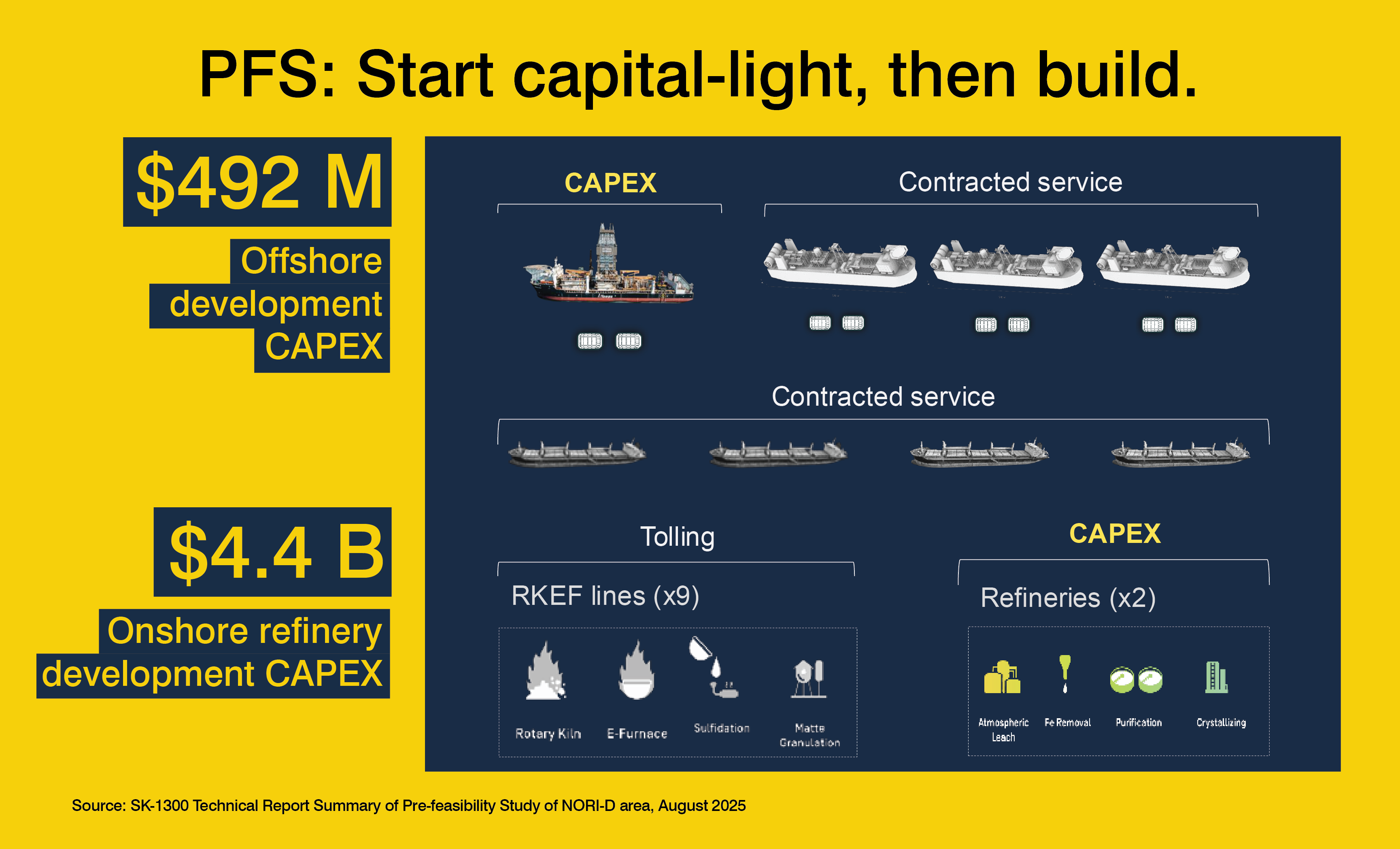
Initial Mining Area Holds ~51 Million Tonnes of Probable Mineral Reserves.
Covering approximately 25% of the NORI-D measured and indicated mineral resource, the probable Mineral Reserves of 51Mt are expected to support the first seven to eight years of operations. Probable Mineral Reserves were derived using sampling protocols involving box coring, autonomous underwater vehicle (AUV) surveys, and advanced geostatistical methods such as kriging and conditional simulation.
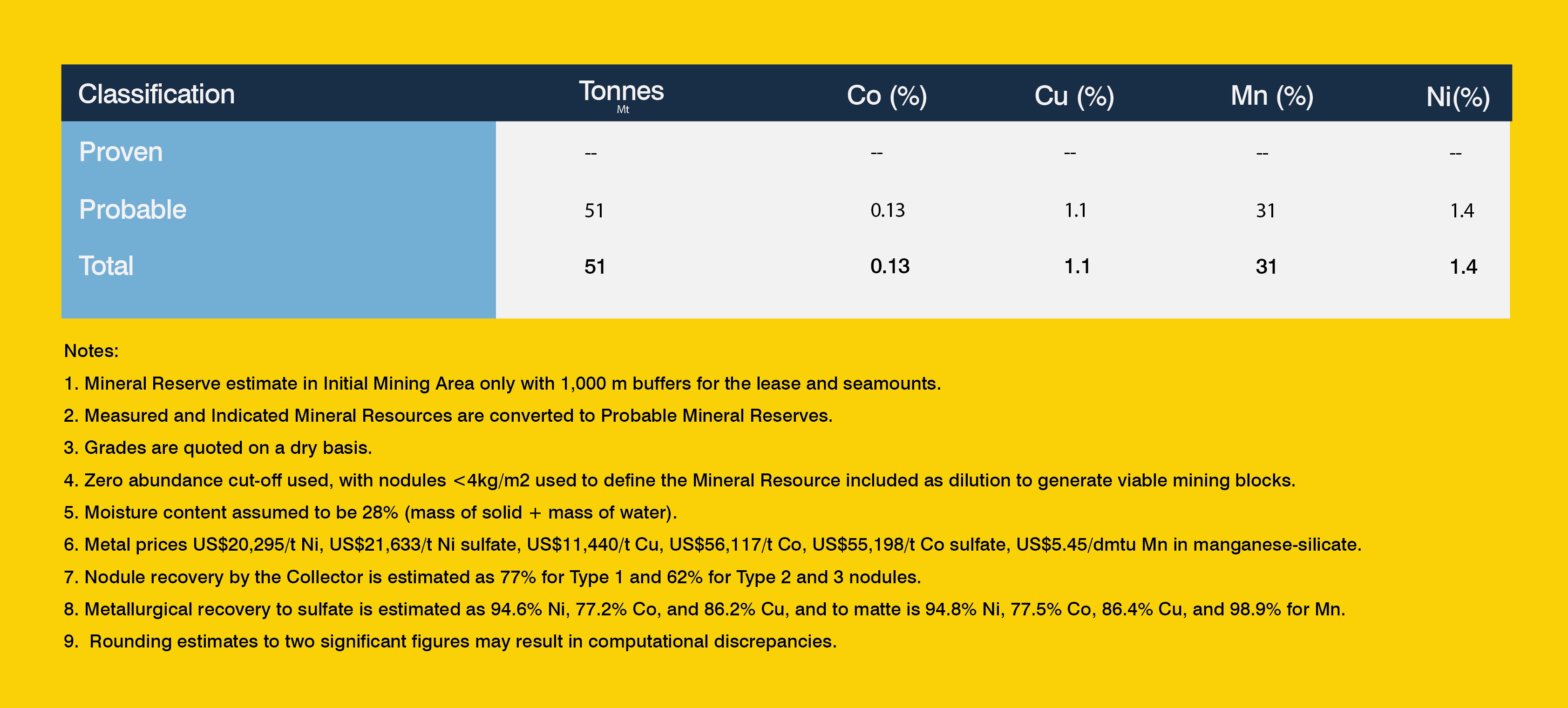
The Mineral Resource estimate for NORI-D exclusive of Mineral Reserves totals approximately 274Mt of wet nodules, classified into Measured, Indicated, and Inferred categories. The resource model excludes areas with slopes greater than 6° and volcanic highs.
The sampling campaigns followed standardized QA/QC protocols, including the use of certified reference materials, blanks, and duplicate assays. The remarkable consistency gives TMC strong confidence that the reported metal grades are not just accurate—but highly representative of what lies on the seafloor.
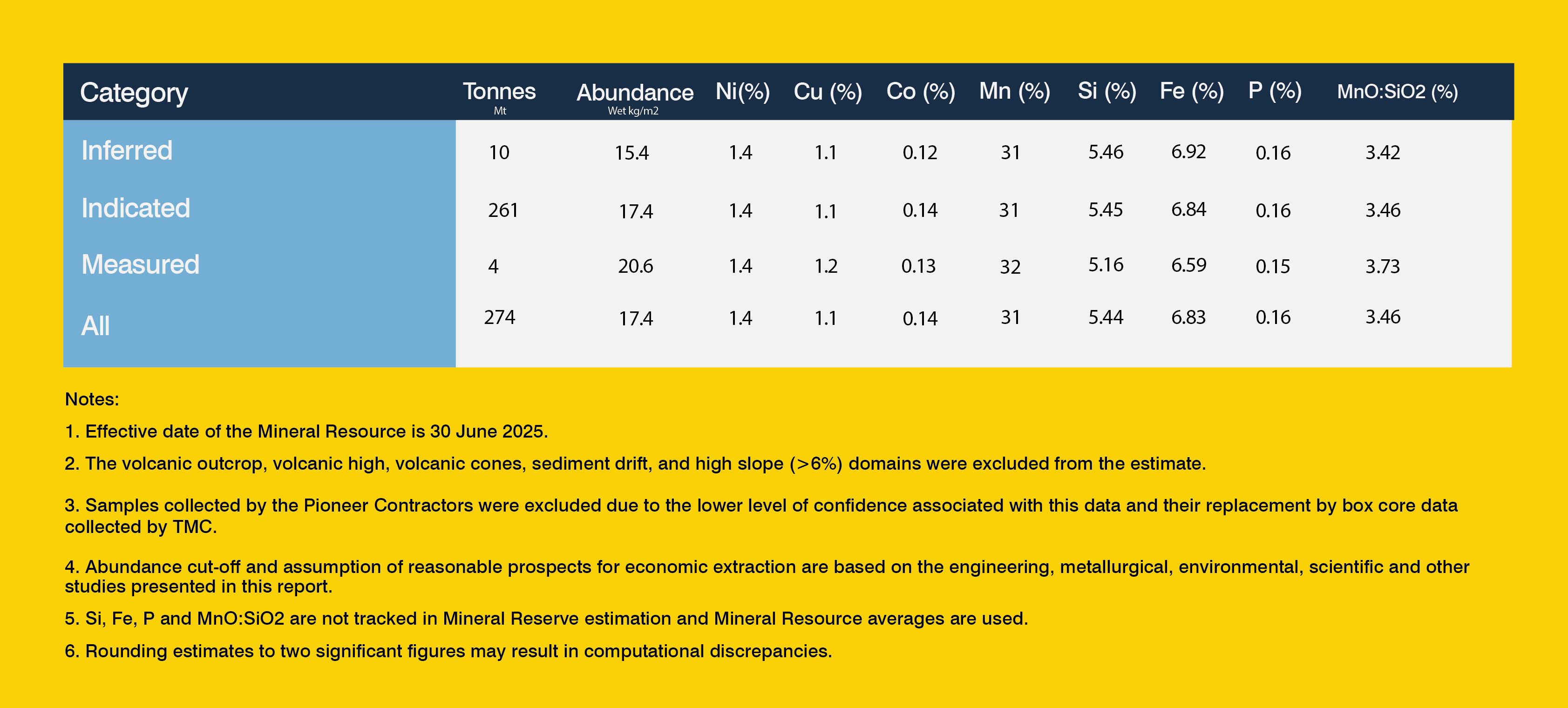
The Initial Mining Area defining the Probable Mineral Reserves contains approximately 25% of the NORI-D Mineral Resource and the conversion of Mineral Resources in the Mining Area to Mineral Reserves is approximately 45%.
Based on additional high-resolution seafloor imagery and detailed mine planning, the study estimates that a further 113 Mt of wet nodules could be recoverable from NORI-D outside the Initial Mining Area, bringing the total recoverable nodules in NORI-D to 164 Mt. Adjusting for moisture content, that represents an estimated 1.6 Mt of contained nickel— potentially enough to support the production of batteries for tens of millions of electric vehicles, manufacture specialty alloys for advanced defense systems, or build the backbone of next-generation energy infrastructure.
From Zero to One: Scaling Up to Full Production
The PFS highlights that initial operations could begin in the designated Initial Mining Area, with one, and later two, collectors deployed from the first Production Vessel to reach an early production target of 3 Mtpa of wet nodules. As additional PVs are brought online, the study anticipates that output will ramp up toward an average steady-state capacity of approximately 10.8 Mtpa (wet). The mine plan is designed for flexibility and responsible growth, incorporating real-time environmental monitoring and adaptive management practices. The Company believes this iterative approach allows for continuous refinement of collection paths and operational strategy — supporting an efficient scale-up while actively managing technical and environmental risks throughout the life of the project.
The PFS assumes that polymetallic nodules will be collected using self-propelled, tracked vehicles equipped with nozzles that direct a jet of seawater across the tops of the nodules to gently uplift them from the seafloor — without the need for digging, drilling, or blasting. Inside the collector, nodules are separated from the entrained sediment and excess water before being transported through a 500-meter flexible jumper hose to a riser system engineered by Allseas, which injects compressed air at a depth of 2,500 meters to lift the nodules 4,300 meters to the surface, enabling efficient transport to the production vessel.
Once at the surface, nodules will be dewatered and transferred to the hold of the production vessel, with all remaining seawater and sediment returned into the water column at a depth of 2,000 meters as recommended by independent marine scientists.
Far from a simple blueprint, the NORI-D mine plan is the product of years of advanced modeling, seafloor mapping, and geotechnical analysis. It weaves together exclusion zones for protected reference areas, environmental buffers around sensitive terrain, and slope-avoidance measures to create a meticulously sequenced extraction schedule—one that maximizes the recovery of valuable metals while minimizing disruption to the deep-sea environment. Each elongated mining block is precisely aligned with the natural contours of the seafloor and prevailing current patterns, guided by terabytes of bathymetric and sediment data collected over more than a decade.
Delivering Scalable Processing with Proven Technology
The PFS assumes that the NORI-D Project will employ well-established RKEF technology—commonly used in the processing of nickel laterites—to convert polymetallic nodules into high-value products, including nickel-copper-cobalt alloy and manganese silicate. TMC's flowsheet would then processes the alloy through sulfidation and converting steps to produce matte, which would be refined using hydrometallurgical techniques into copper cathode, nickel and cobalt sulfates, and fertilizer-grade ammonium sulfate.
By adapting proven industrial technologies for use with a new and abundant feedstock, TMC will pursue a pragmatic and capital-efficient processing path that maximizes metal recovery while minimizing solid waste. The Company believes this approach offers a clear and scalable route to responsibly deliver critical minerals into global supply chains.
*The table below outlines the anticipated steady state product mix and volumes of the wet nodules that would be recovered in the areas subject to the NORI-D Project.

Initial Assessment: Evaluating the Full Scope of TMC's Resource
In addition to the PFS, TMC also released an Initial Assessment (IA) outlining the potential of its remaining resource in the TOML and NORI areas outside of NORI-D.
The IA presents a development plan for the NORI and TOML polymetallic nodule projects, encompassing a 23-year mining operation that employs advanced second-generation offshore collection systems with remotely operated Collector Vehicles and Production Vessels.
The IA indicates collection of approximately 670 Mt of wet polymetallic nodules across the NORI and TOML contract areas, with average grades of 1.3% nickel, 0.2% cobalt, 1.1% copper, and 28.8% manganese. It outlines an After-tax Net Present Value of $18.1 billion and an After-tax Internal Rate of Return of 35.6%, with a steady-state average EBITDA margin of 57%. These findings underscore the massive scale and economic strength of a resource base that positions TMC to deliver on its long-term strategy to build secure, circular metals supply chains to support energy, defense, manufacturing and infrastructure for generations to come.
*The table below sets forth the anticipated recoverable polymetallic nodules, the anticipated costs, the anticipated revenue, anticipated return and anticipated net project value in the NORI and TOML contract areas, excluding NORI-D
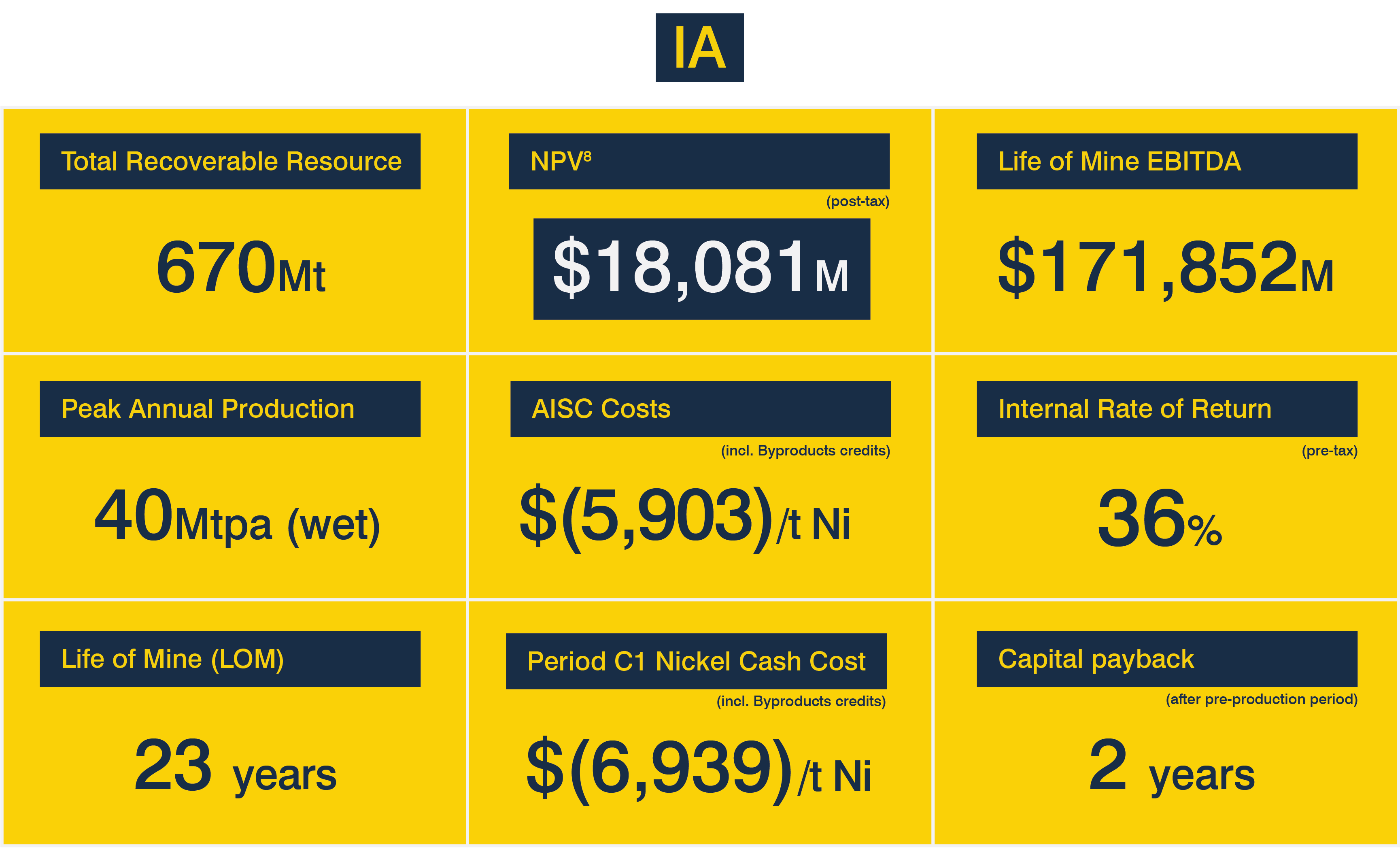
Deploying Next-Gen Systems to Drive the Next Phase of Growth
With a vast and scalable resource opportunity outlined in the Initial Assessment, we believe TMC is setting the stage for future growth. The development plan set out in the IA is preliminary in nature and intended to illustrate a potential scenario for future operations.
Nodules are assumed to be transported to Indonesia for processing into a matte product and manganese silicate through a tolling arrangement utilising existing processing infrastructure. The matte product would then be shipped to Texas on existing bulk carriers for further refining through a new refining facility developed by TMC with support from strategic partners.
Operations are assumed to commence in the TOML-F area with one PV producing 7 Mtpa of wet nodules and commencing in 2037. The IA assumes an additional two PVs would come online in 2038 and 2039 bringing total production from TOML-F to 21 Mtpa (wet). TOML-F is scheduled to be mined before the PVs relocate to the west for collection in other TOML and NORI areas that show lower abundance, reducing the production rate per PV to 5 Mtpa (wet).
Upon arrival in Indonesia, the IA assumes that nodules would be offloaded from the Transport Vessels and transferred to existing RKEF facilities for processing into a nickel-copper-cobalt matte and manganese silicate product, thereby reducing upfront capital and aligning processing capabilities with the ramp-up of production capacity offshore.
The processed matte would then be loaded to bulk carriers and shipped to Texas. Manganese silicate is planned to be sold to market. The IA refining strategy involves construction of two additional refining facilities (anticipated to be 12 Mtpa wet nodule equivalent nameplate capacity each) in the United States to refine the matte and produce copper cathode, nickel sulfate, and cobalt sulfate.
CAPEX on offshore operations and RKEF facilities are expected to be managed as capital-light, by TMC entering operating agreements with contract miners and transport providers who would manage the collection and delivery of nodules to shore. The IA assumes that bulk carriers running between Indonesia and the United States are expected to be owned and operated by third parties, with TMC paying through standard shipping charges. All processing facilities in Indonesia are assumed to be owned and operated by third parties, with TMC paying for toll treatment per tonne of nodules. The IA assumes that all refining facilities in the U.S. would be TMC assets.
Comparing the PFS and the IA
*The table below summarizes the key findings under the PFS and IA, and presents combined results. The summary does not purport to be complete and is qualified in its entirety by the PFS and IA. Readers are encouraged to read the PFS and IA in their entirety.
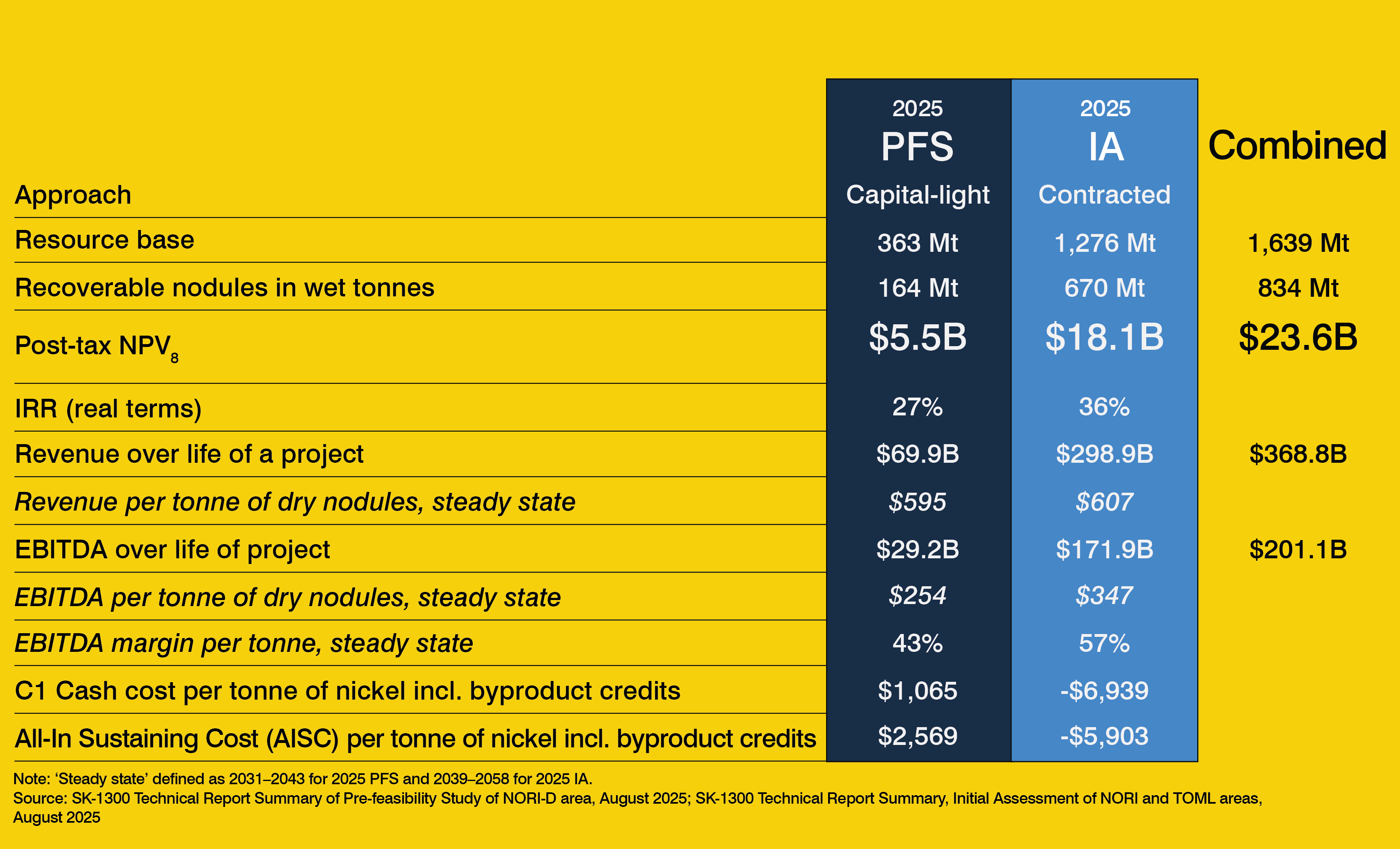
About The Metals Company
The Metals Company is a developer of lower-impact critical metals from seafloor polymetallic nodules, on a dual mission: (1) supply metals for energy, defense, manufacturing and infrastructure with net positive impacts compared to conventional production routes and (2) trace, recover and recycle the metals we supply to help create a metal commons that can be used in perpetuity. The Company has conducted more than a decade of research into the environmental and social impacts of offshore nodule collection and onshore processing. More information is available at www.metals.co.
More Info
Media | media@metals.co
Investors | investors@metals.co
Cautionary Statements Regarding the Pre-Feasibility Study and the Initial Assessment
The NORI-D Pre-Feasibility Study and the NORI and TOML Initial Assessment contain forward-looking information derived from preliminary economic assessments and conceptual development scenarios that are subject to significant uncertainty. The report for NORI-D does not represent a feasibility study and does not support a development decision. Similarly, the Initial Assessment of the TOML and NORI is not a declaration of mineral reserves and is not sufficient to determine the economic viability of a mining project. In addition, such Initial Assessment reports inferred mineral resources, which have a high degree of uncertainty as to their existence and to whether they can be economically or legally commercialized, under the SEC rules may not form the basis of an economic analysis and for which you cannot assume any part thereof will ever be upgraded to a higher category. Until mineral deposits are actually mined and processed, mineral resources and mineral reserves must be considered as estimates only. The estimates, projections, and analyses contained in the reports are based on numerous assumptions, including those related to recovery methods, costs, infrastructure, financing, regulatory approvals, and market conditions, many of which are beyond TMC's control. Actual results may differ materially from those presented. Investors are cautioned not to place undue reliance on these reports and are encouraged to review the full summaries and underlying assumptions.
Forward Looking Statements
This press release contains “forward-looking” statements and information within the meaning of the Private Securities Litigation Reform Act of 1995 and other applicable U.S. securities laws. These statements may be identified by words such as “believes,” “could,” “expects,” “may,” “plans,” “possible,” “potential,” “will” and variations of these words or similar expressions, although not all forward-looking statements contain these words. Forward-looking statements in this press release include, but are not limited to, statements with respect to the results of the Pre-Feasibility Study (PFS) and Initial Assessment (IA), including estimated mine life, project economics, capital and operating cost projections, resource and reserve estimates, expected production volumes, recoveries and grades; TMC's plans to advance development of the NORI-D Project; the anticipated permitting path under U.S. law; the expected regulatory process with the International Seabed Authority; the feasibility and scalability of TMC's capital-light execution strategy; the potential timing of commercial production; TMC's ability to secure strategic partnerships, tolling arrangements, and refining capacity; and TMC's belief that the PFS and IA support the economic viability and long-term value of its polymetallic nodule resources. TMC may not actually achieve the plans, intentions or expectations disclosed in these forward-looking statements, and you should not place undue reliance on these forward-looking statements. Actual results or events could differ materially from the plans, intentions and expectations disclosed in these forward-looking statements as a result of various factors, including, among other things: risks related to the accuracy of mineral resource and reserve estimates and technical assumptions in the PFS and IA; changes in demand for and prices of critical metals; risks related to TMC's ability to obtain necessary regulatory approvals, including those from the International Seabed Authority and under the U.S. Deep Seabed Hard Mineral Resources Act (DSHMRA); the outcome and timing of reviews by NOAA or other U.S. government agencies; uncertainties associated with TMC's dual-path permitting strategy; the availability and performance of future offshore and onshore processing infrastructure; risks related to environmental impacts and the ability to meet evolving environmental standards and obtain required environmental approvals; risks related to financing needs and the availability of capital; TMC's limited operating history; and other risks and uncertainties, any of which could cause actual results to differ from those expressed or implied in the forward-looking statements. For a discussion of these and other risks and uncertainties, and other important factors, any of which could cause TMC's actual results to differ materially from those contained in the forward-looking statements, see the section entitled “Risk Factors” in TMC's Annual Report on Form 10-K for the year ended December 31, 2024, filed with the U.S. Securities and Exchange Commission (SEC) on March 27, 2025, as well as in TMC's subsequent Quarterly Reports on Form 10-Q and Current Reports on Form 8-K filed with the SEC. Forward-looking statements are based on current expectations and assumptions and reflect TMC's views as of the date hereof. TMC undertakes no obligation to update any forward-looking statements contained herein, whether as a result of new information, future events or otherwise, except as required by law.
Photos accompanying this announcement are available at:
https://www.globenewswire.com/NewsRoom/AttachmentNg/9d444ab7-3841-4b3e-afd6-4f443af953c8
https://www.globenewswire.com/NewsRoom/AttachmentNg/31f1fbb9-659d-4e90-b339-65d4122071c2
https://www.globenewswire.com/NewsRoom/AttachmentNg/c4932696-49cb-405b-96ac-a7fb6821def0
https://www.globenewswire.com/NewsRoom/AttachmentNg/1680dc3f-7312-4958-b74f-2becae36dbd7
https://www.globenewswire.com/NewsRoom/AttachmentNg/3da589b9-3945-45e5-a238-28e8de0f652e
https://www.globenewswire.com/NewsRoom/AttachmentNg/bdfa0c7d-e678-46c4-968d-09d4336a6679
https://www.globenewswire.com/NewsRoom/AttachmentNg/369946e8-55a7-43da-991d-46a5a2159d63
https://www.globenewswire.com/NewsRoom/AttachmentNg/185bccb3-0694-467e-8561-a174c4ede4d9
https://www.globenewswire.com/NewsRoom/AttachmentNg/fb28ed69-2ec9-417d-b9ef-4c392d6de07e
- Cognite联合创始人Geir Engdahl被任命为首席产品官
- 解密成都熠翊发服饰有限公司集合店童装弘扬工匠精神锻造良心品质
- Venture Global, Inc.宣布首次公开募股定价
- Keyloop完成对Automotive Transformation Group (ATG)的收购
- AI+大数据,破解社群营销找群难题
- 万纬物流绿色认证面积达860万平 累计减碳12500吨
- 从国康医养管家拓荒到高校育才:养老专业人才链筑基的20年
- 突然爆火!这种“防偷窥神器”容易伤眼,很多福建人还在用.....
- 冷靖:鹤情真爱纤丝渺,月告他乡知音眺。动情诗三十六首。
- 自酿啤酒设备小型啤酒设备如何选择济南正麦机械设备有限公司
- Andersen增加在阿根廷、智利、哥伦比亚和墨西哥的业务,扩大整个拉丁美洲的评估能力
- 桂东县支行支持桂东县“两茶一药”特色种植产业
- 上海生命教育创新发展合作体在沪成立
- 万象皆歌everySings音乐与AI技术的邂逅,内测启动
- 热烈祝贺加立净科技股份有限公司挂牌成功,正式登陆上海股交中心!
- 技术、人才双驱动,葫芦娃药业展现强劲发展势头
- 电影《爱在文昌》开机演员念真挑战当代律政佳人
- Shopee全托管再放大招:“揽收服务”运费补贴冲顶40%!
- 新商科背景下高校电子商务专业师资队伍培训路径研究
- 【昆娜宸星学院】七一特邀103位明星,共贺党的103岁诞辰
- PCI Pharma Services位于新罕布什尔州贝德福德的园区顺利通过国际药品监管机构联盟的检查
- IFF Opens New State-of-the-art Office in Hyderabad, India
- OBI Pharma Announces U.S. FDA Clearance of IND Application for a Phase 1/2 Study of OBI-902, a Trop-
- WS创意点燃市场:WhatsApp工具为你带来全新招数,消息独具魅力,点燃关注热潮
- IDC权威发布!奥哲再次获得中国低零代码独立厂商第一!
- 陕西画家张新军出席中国国家画院开学典礼暨教学观摩展开幕式
- 再赴“美国春晚”,新亚胜以创新技术点亮超级碗舞台
- 亿力清洗科技(苏州)有限公司:清洗科技领域的璀璨明星
- 唢呐声中家乡情,山水交融古韵闪-鱼潇
- NinjaTech launches Super Agent
推荐
-
 中国减排方案比西方更有优势
如今,人为造成的全球变暖是每个人都关注的问
资讯
中国减排方案比西方更有优势
如今,人为造成的全球变暖是每个人都关注的问
资讯
-
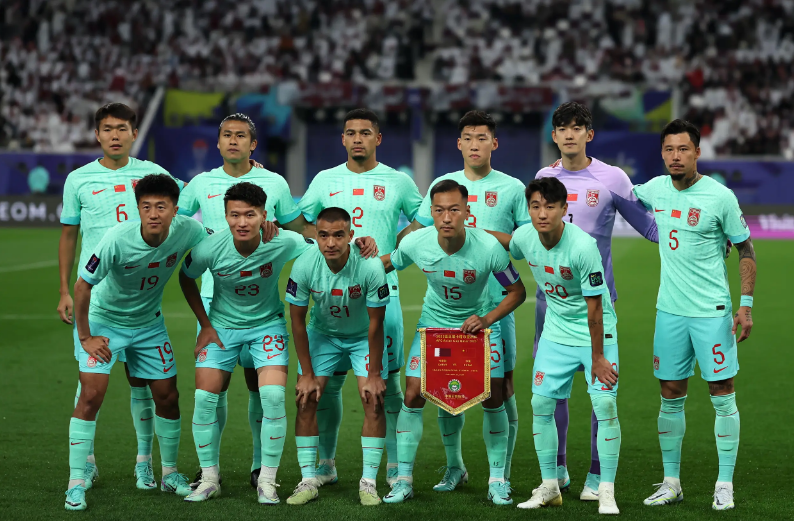 国足13次出战亚洲杯首次小组赛0进球
北京时间1月23日消息,2023亚洲杯小组
资讯
国足13次出战亚洲杯首次小组赛0进球
北京时间1月23日消息,2023亚洲杯小组
资讯
-
 男子“机闹”后航班取消,同机旅客准备集体起诉
1月4日,一男子大闹飞机致航班取消的新闻登上
资讯
男子“机闹”后航班取消,同机旅客准备集体起诉
1月4日,一男子大闹飞机致航班取消的新闻登上
资讯
-
 大家一起关注新疆乌什7.1级地震救援见闻
看到热气腾腾的抓饭马上就要出锅、村里大家
资讯
大家一起关注新疆乌什7.1级地震救援见闻
看到热气腾腾的抓饭马上就要出锅、村里大家
资讯
-
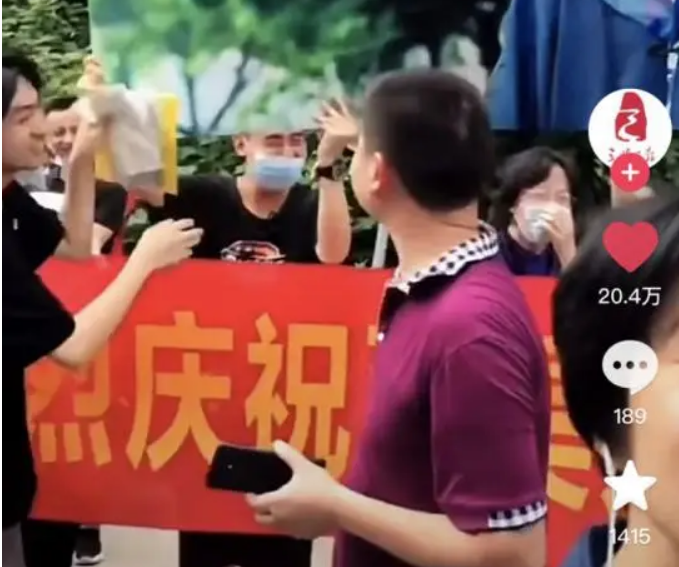 一个“江浙沪人家的孩子已经不卷学习了”的新闻引发议论纷纷
星标★
来源:桌子的生活观(ID:zzdshg)
没
资讯
一个“江浙沪人家的孩子已经不卷学习了”的新闻引发议论纷纷
星标★
来源:桌子的生活观(ID:zzdshg)
没
资讯
-
 奥运冠军刘翔更新社交账号晒出近照 时隔473天更新动态!
2月20日凌晨2点,奥运冠军刘翔更新社交账号晒
资讯
奥运冠军刘翔更新社交账号晒出近照 时隔473天更新动态!
2月20日凌晨2点,奥运冠军刘翔更新社交账号晒
资讯
-
 新增供热能力3200万平方米 新疆最大热电联产项目开工
昨天(26日),新疆最大的热电联产项目—&md
资讯
新增供热能力3200万平方米 新疆最大热电联产项目开工
昨天(26日),新疆最大的热电联产项目—&md
资讯
-
 私域反哺公域一周带火一家店!
三四线城市奶茶品牌茶尖尖两年时间做到GMV
资讯
私域反哺公域一周带火一家店!
三四线城市奶茶品牌茶尖尖两年时间做到GMV
资讯
-
 看新东方创始人俞敏洪如何回应董宇辉新号分流的?
(来源:中国证券报)
东方甄选净利润大幅下滑
资讯
看新东方创始人俞敏洪如何回应董宇辉新号分流的?
(来源:中国证券报)
东方甄选净利润大幅下滑
资讯
-
 抖音直播“新红人”进攻本地生活领域
不难看出,抖音本地生活正借由直播向本地生活
资讯
抖音直播“新红人”进攻本地生活领域
不难看出,抖音本地生活正借由直播向本地生活
资讯

